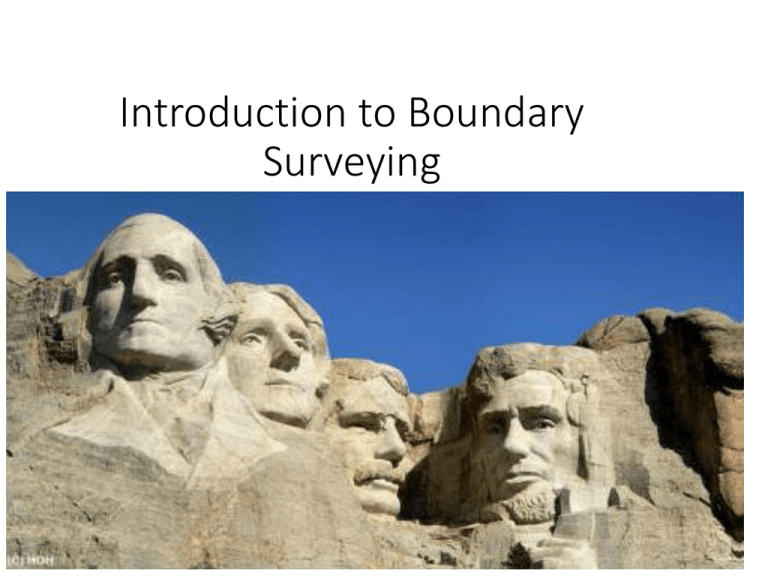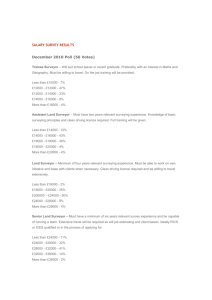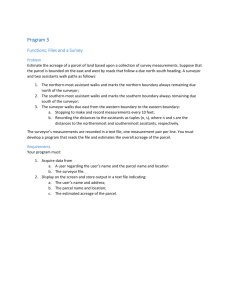Land Measurement
advertisement

Introduction to Boundary Surveying Property Rights • REAL AND PERSONAL PROPERTY DISTINCTION • Real Property • Fixed • Immobile • Permanent • Personal Property • Movable • Consumable Role of the Surveyor • CREATION OF BOUNDARY LINES • Boundary lines are created by surveyors; • property lines are created by law Role of the Surveyor • A boundary is a closed geometric figure. This allows an entity to claim rights within this boundary. Monuments are frequently used to identify the corners as evidence of the boundary. • Once a surveyor has created a boundary, it remains in perpetuity (changes may be made in the future). This boundary separates the rights to be claimed by two entities. • Once created, another surveyor attempts to reconstruct the intent and location of the boundaries. The later surveyor, after consideration, gives his/her OPINION of the location of the boundaries. • In the USA, only courts have the authority to determine specifically the location of retraced boundary lines. WHAT DOES A SURVEYOR DO? A Licensed Surveyor does NOT determine property ownership. The Surveyor gives his/her professional opinion as to the locations of the Boundary Lines. The opinion is based on the following work: • Research -- Yes, a surveyor does research on your property but he/she is also required to do some research on your neighboring properties, as well-as the right-of-way that your property is on. • Field Work -- A surveyor will come to your property and map out locations of streets, fences, structures, know property corners located on your property along with some that are located on adjacent propertys in order to properly determine your complete boundary. • Drafting -- A surveyor will draw your deed and or plat along with the adjoining properties and then will overlay the field measurements taken to finalize his opinion of where your property corners are located. • Setting Monumentation -- A surveyor will then come back to the property to set monumentation at every unmonumented property corner location. • Plat -- The Professional Surveyor is required by Law to produce a plat with every boundary survey performed. • Descriptions -- In the Commonwealth of Kentucky, a licensed professional land surveyor is the only one allowed to write a legal description of the survey. Land Measurement is needed for: You should consider contacting a Licensed Surveyor when: • Buying, selling, investing in, or developing property. • Boundary location is unknown or unclear. • Before improvements are made (buildings, fences, excavation, etc.) • To stop encroachments from adjoining owners. • To establish easements and rights of way. • Timber is cut near a property boundary line. • Recommended by a lending institution. • Dividing a large tract of land into a smaller tract or tracts. • Combining separate tracts into one tract. • You believe that your property is incorrectly located in a flood plain. Early Surveyors’ Equipment Burt Solar Compass Commonly used length units • 1 mile = 5280 feet = 80 chains • 1 chain = 66 feet = 100 links • 1 rod = 16.5 feet • 4 rods = 1 chain Commonly used area units • 1 acre = 43,560 square feet • 10 square chains = 1 acre • 1 square mile = 640 acres m/l • 1 hectare = 10,000 square meters • 1 hectare = 2.471 acres Legal Descriptions and Land Survey Two systems used in U.S. • Metes and bounds • • • • • • • Original 13 colonies Maine Vermont West Virginia Kentucky Tennessee Texas • Public Land Survey • Remaining continental states • Alaska • Hawaii Survey Systems in U.S. Metes & Bounds Public Land Survey Metes and Bounds System Mete: A direction, or more often a combination of a distance and direction i.e. N 42o E, 16.3 chains Bound: description of the boundary of an adjoining property i.e. the southwest boundary of the Johnson property Metes and Bounds Metes & Bounds Problems • Difficult to reconstruct • Often inaccurate • Kentucky had 1,275,000 acres not recorded • Virginia • 40 counties with 554,000 ac. more than their combined area • 55 counties with 370,000 ac. less than their combined land area Public Land Survey, General Land Office (GLO Survey), Rectangular Survey Public Land Survey • Started in Ohio in 1785 • Provides a very uniform method for land description • Easy to re-establish • Less likelihood of errors than with Metes and Bounds Each GLO survey starts from a known hub • Hubs were usually established at the confluence of two rivers • Locations were determined accurately by celestial observation GLO Survey







